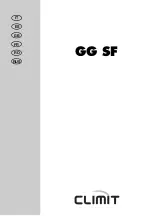
Installation and Operation Manual
TFTN 085-199
16
Table 4-1 Corrosive Products and Contaminant Sources
Products to Avoid
Contaminated Sources to Avoid
Antistatic fabric softeners, bleaches, detergents, cleaners
Laundry facilities
Perchloroethylene (PCE), hydrocarbon-based cleaners
Dry cleaning facilities
Chemical fertilizer, herbicides/pesticides, dust, methane gas
Farms or areas with livestock and manure
Paint or varnish removers, cements or glues, sawdust
Wood working or furniture refinishing shops
Water chlorination chemicals (chloride, fluoride)
Swimming pools, hot tubs
Solvents, cutting oils, fiberglass, cleaning solvents
Auto body or metal working shops
Refrigerant charge with CFC or HCFC
Refrigerant repair shops
Permanent wave solutions
Beauty shops
Fixer, hydrochloric acid (muriatic acid), bromide, iodine
Photo labs, chemical / plastics processing plants
Cement powder, crack fill dust, cellulose, fiber-based insulation Concrete plant or construction site
Do not store or use gasoline or other flammable vapors and liquids in the vicinity of this or any
other boiler. Failure to follow instructions may result in serious injury or death.
It is
BEST PRACTICE
to pipe the combustion air intake directly to the outdoors (Direct Vent
installation) to avoid contamination often contained in indoor air.
4.3
Flammable Solvents and Plastic Piping
Due to the extremely flammable characteristics of most glues, cements, solvents, and primers used in the process of joining
plastic vent and air intake pipe, explosive solvent vapors must be evacuated from the vent and air intake prior to start-up.
Avoid using excess cement or primer that may lead to pooling inside the pipe assembly. Freshly assembled piping assembly
should be allowed to cure for a minimum of 8 hours before applying power to the gas fired boiler. Refer to
Mandatory Pre-
commissioning Procedure for Plastic Venting
in this section.
Flammable Cements and Primers
–
It is the installers’ responsibility to familiarize themselves with
the hazards associated with explosive solvents and to take all precautions to reduce these risks.
Failure to follow these instructions can cause explosions, property damage, injury or death.
Mandatory Pre-commissioning Procedure for Plastic Venting (PVC or CPVC)
Do not apply power to the boiler prior to Step 4 in the Mandatory Pre-commissioning Procedure
for Plastic Venting.
1)
Working with the power turned off to the boiler, completely install the vent and air intake system, securely cementing
joints together. If possible, allow primers/cements to cure for 8 hours before firing the burner. If curing time is less than
8 hours, proceed with Steps 2 through 6.
2)
Maintain the boiler gas supply shut-off valve in the off position.
3)
Remove the cable from the Spark Ignition Transformer.
Spark Ignition Circuit
- Maintain a safe distance (2 inches minimum) from the spark ignition
circuit to avoid injury from electrical shock.
4)
Turn power on to the boiler and apply a heat demand.
5)
Allow for 3 complete trials for ignition, consisting of pre and post purge of the combustion blower, until an ignition
lockout occurs. Repeat the process two more times (i.e., 9 complete ignition sequences in total).
6)
Turn power off and reconnect the cable to the Spark Ignition Transformer.
















































